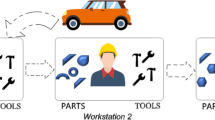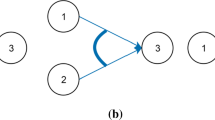Abstract
The balancing of the disassembly line directly affects the productivity of the disassembly process. The disassembly line balancing (DLB) problem can be determined as assigning the tasks to serial workstations to optimize some performance measures like number of workstations, cycle time, removing hazardous parts earlier, etc. The aim of the paper is to develop an efficient heuristic algorithm to minimize the number of workstations under a pre-known cycle time. In this paper, a genetic algorithm (GA) and a constructive heuristic based on the Dijkstra algorithm is proposed to solve the DLB problem with stochastic task times that is caused by the nature of disassembly operation. The proposed algorithms are tested on benchmark problems and compared with the results of the piecewise-linear model (PLM) and simulated annealing (SA). The average relative percentage deviation is applied to transfer the obtained number of workstations. The results obtained by GA are clearly superior in all tests problem according to average relative percentage deviation. Moreover, the proposed constructive heuristic based on the Dijkstra algorithm is also superior to PLM and SA algorithm with respect to number of workstations and the computational times. The proposed approaches can be a very competitive and promising tool for further research in DLB literature and real cases in industries according to test results. Disassembly lines which need less time or number of workstations for balancing may be simply designed by the proposed techniques.








Similar content being viewed by others
References
Ağpak, K., & Gökçen, H. (2007). A chance-constrained approach to stochastic line balancing problem. European Journal of Operational Research, 180(3), 098–1115.
Agrawal, S., & Tiwari, M. K. (2008). A collaborative ant colony algorithm to stochastic mixed-model U-shaped disassembly line balancing and sequencing problem. International Journal of Production Research, 46(6), 1405–1429.
Altekin, F. T. (2016). A piecewise linear model for stochastic disassembly line balancing. IFAC-Papers on Line, 49(12), 932–937.
Altekin, F. T., & Akkan, C. (2012). Task-failure-driven rebalancing of disassembly lines. International Journal of Production Research, 50(18), 4955–4976.
Altekin, F. T., Bayındır, Z. P., & Gümüşkaya, V. (2016). Remedial actions for disassembly lines with stochastic task times. Computers and Industrial Engineering, 99, 78–96.
Altekin, F. T., Kandiller, L., & Ozdemirel, N. E. (2008). Profit-oriented disassembly line balancing. International Journal of Production Research, 46(10), 2675–2693.
Aydemir-Karadag, A., & Turkbey, O. (2013). Multi-objective optimization of stochastic disassembly line balancing with station paralleling. Computers & Industrial Engineering, 65, 413–425.
Bagher, M., Zandieh, M., & Farsijani, H. (2011). Balancing of stochastic U-type assembly lines: An imperialist competitive algorithm. International Journal of Advanced Manufacturing Technology, 54, 271–285.
Baykasoğlu, A., & Özbakır, L. (2007). Stochastic U-line balancing using genetic algorithms. International Journal of Advanced Manufacturing Technology, 32, 139–147.
Bentaha, M. L., Battaïa, O., & Dolgui, A. (2014). A sample average approximation method for disassembly line balancing problem under uncertainty. Computers and Operations Research, 51, 111–122.
Celik, E., Kara, Y., & Atasagun, Y. (2014). A new approach for rebalancing of U-lines with stochastic task times using ant colony optimization algorithm. International Journal of Production Research, 52(24), 7262–7275.
Chiang, W. C., & Urban, T. L. (2006). The stochastic u-line balancing problem: A heuristic procedure. European Journal of Operational Research, 175(3), 1767–1781.
Çil, Z. A., Kizilay, D., Li, Z., & Öztop, H. (2022). Two-sided disassembly line balancing problem with sequence-dependent setup time: A constraint programming model and artificial bee colony algorithm. Expert Systems with Applications., 203, 117529.
Çil, Z. A., Mete, S., & Serin, F. (2020). Robotic disassembly line balancing problem: A mathematical model and ant colony optimization approach. Applied Mathematical Modelling, 86, 335–348.
Deniz, N., & Ozcelik, F. (2019). An extended review on disassembly line balancing with bibliometric & social network and future study realization analysis. Journal of Cleaner Production, 225(1), 697–715.
Ding, L.-P., Tan, J.-R., Feng, Y.-X., & Gao, Y.-C. (2009). Multi objective optimization for disassembly line balancing based on pareto ant colony algorithm. Computer Integrated Manufacturing Systems, 15(7), 1406–1413.
Fang, Y., Ming, H., Li, M., Liu, Q., & Pham, D. T. (2020). Multi-objective evolutionary simulated annealing optimisation for mixed-model multi-robotic disassembly line balancing with interval processing time. International Journal of Production Research, 58(3), 846–862.
Goldberg, D. E. (1989). Genetic algorithms in search, optimization, and machine learning. Addison-Wesley.
Güngör, A., and Gupta, S.M., 1999, Disassembly line balancing, Proceedings of the 1999 Annual Meeting of the Northeast Decision Sciences Institute, 193–19
Güngör, A., & Gupta, S. M. (2001). A solution approach to the disassembly line balancing problem in the presence of task failures. International Journal of Production Research, 39(7), 142–1467.
He, J., Chu, F., Zheng, F., & Liu, M. (2021). A green-oriented bi-objective disassembly line balancing problem with stochastic task processing times. Annals of Operations Research, 296, 71–93.
Hezer, S., & Kara, Y. (2015). A network-based shortest route model for parallel disassembly line balancing problem. International Journal of Production Research, 53(6), 1849–1865.
Ilgin, M. A., Akçay, H., & Araz, C. (2017). Disassembly line balancing using linear physical programming. International Journal of Production Research, 55(20), 6108–6119.
Ilgin, M. A., & Gupta, S. M. (2010). Environmentally conscious manufacturing and product recovery (ECMPRO): A review of the state of the art. Journal of Environmental Management, 91, 563–591.
Kalayci, C. B., & Gupta, S. M. (2013a). A particle swarm optimization algorithm with neighborhood-based mutation for sequence-dependent disassembly line balancing problem. The International Journal of Advanced Manufacturing Technology, 69(1–4), 197–209.
Kalayci, C. B., & Gupta, S. M. (2013b). Ant colony optimization for sequence-dependent disassembly line balancing problem. Journal of Manufacturing Technology Management, 24(3), 413–427.
Kalaycılar, E. G., Azizoğlu, M., & Yeralan, S. (2016). A disassembly line balancing problem with fixed number of workstations. European Journal of Operational Research, 249(2), 592–604.
Kazancoglu, Y., & Ozturkoglu, Y. (2018). Integrated framework of disassembly line balancing with Green and business objectives using a mixed MCDM. Journal of Cleaner Production, 191, 179–191.
Ketzenberg, M. E., Souza, G. C., & Guide, V. D. R. (2003). Mixed assembly and disassembly operations for remanufacturing’. Production and Operations Management, 12(3), 320–335.
Koç, A., Sabuncuoğlu, I., & Erel, E. (2009). Two exact formulations for disassembly line balancing problems with task precedence diagram construction using an AND/OR graph. IIE Transactions, 41(10), 866–881.
Li, Z., Çil, Z. A., Mete, S., & Kucukkoc, I. (2020). A fast branch, bound and remember algorithm for disassembly line balancing problem. International Journal of Production Research, 58(11), 3220–3234.
Li, Z., Kucukkoc, I., & Zhang, Z. (2019). Iterated local search method and mathematical model for sequence-dependent U-shaped disassembly line balancing problem. Computers & Industrial Engineering. https://doi.org/10.1016/j.cie.2019.106056
Liu, M., Liu, X., Chu, F., Zheng, F., & Chu, C. 2020b. An exact method for disassembly line balancing problem with limited distributional information. International Journal of Production Research, 1–18.
Liu, M., Liu, X., Chu, F., Zheng, F., & Chu, C. (2020a). Robust disassembly line balancing with ambiguous task processing times. International Journal of Production Research, 58(19), 5806–5835.
McGovern, S. M., & Gupta, S. M. (2007a). A balancing method and genetic algorithm for disassembly line balancing. European Journal of Operational Research, 179(3), 692–708.
McGovern, S. M., & Gupta, S. M. (2007b). Combinatorial optimization analysis of the unary NP-complete disassembly line balancing problem. International Journal of Production Research, 45(18–19), 4485–4511.
Mete, S., Çil, Z. A., Ağpak, K., Özceylan, E., & Dolgui, A. (2016). A solution approach based on beam search algorithm for disassembly line balancing problem. Journal of Manufacturing Systems, 41(1), 188–200.
Mete, S., Çil, Z. A., Celik, E., & Ozceylan, E. (2019). Supply-driven rebalancing of disassembly lines: A novel mathematical model approach. Journal of Cleaner Production, 213, 1157–1164.
Mete, S., Çil, Z. A., Özceylan, E., Ağpak, K., & Battaïa, O. (2018). An optimisation support for the design of hybrid production lines including assembly and disassembly tasks. International Journal of Production Research, 56(24), 7375–7389.
Özceylan, E., Kalayci, C. B., Güngör, A., & Gupta, S. M. (2019). Disassembly line balancing problem: A review of the state of the art and future directions. International Journal of Production Research, 57(15–16), 4805–4827.
Pistolesi, F., Lazzerini, B., Dalle Mura, M., & Dini, G. (2017). EMOGA: A hybrid genetic algorithm with extremal optimization core for multi objective disassembly line balancing. IEEE Transactions on Industrial Informatics, 14(3), 1089–1098.
Ren, Y., Yu, D., Zhang, C., Tian, G., Meng, L., & Zhou, X. (2017). An improved gravitational search algorithm for profit-oriented partial disassembly line balancing problem. International Journal of Production Research, 55(24), 7302–7316.
Ren, Y., Zhang, C., Zhao, F., Tian, G., Lin, W., Meng, L., & Li, H. (2018). Disassembly line balancing problem using interdependent weights-based multi-criteria decision making and 2-optimal algorithm. Journal of Cleaner Production, 174, 1475–1486.
Riggs, R. J., Battaïa, O., & Hu, S. J. (2015). Disassembly line balancing under high variety of end of life states using a joint precedence graph approach. Journal of Manufacturing Systems, 37(3), 638–648.
Roshani, A., & Giglio, D. (2017). Simulated annealing algorithms for the multi-manned assembly line balancing problem: Minimising cycle time. International Journal of Production Research, 55(10), 2731–2751.
Serin, F., Mete, S., & Çelik, E. (2019). An efficient algorithm for U-type assembly line re-balancing problem with stochastic task times. Assembly Automation., 39(4), 581–595.
Silverman, F. N., & Carter, J. C. (1986). A cost-based methodology for stochastic line balancing with intermittent line stoppages. Management Science, 32(4), 455–463.
Tuncel, E., Zeid, A., & Kamarthi, S. (2014). Solving large scale disassembly line balancing problem with uncertainty using reinforcement learning. Journal of Intelligent Manufacturing, 25(4), 647–659.
Urban, T. L., & Chiang, W. C. (2006). An optimal piecewise-linear program for the u-line balancing problem with stochastic task times. European Journal of Operational Research, 168, 771–782.
Wang, K., Li, X., & Gao, L. (2019). Modelling and optimization of multi-objective partial disassembly line balancing problem considering hazard and profit. Journal of Cleaner Production, 211, 115–133.
Xiao, S., Wang, Y., Yu, H., & Nie, S. (2017). An entropy-based adaptive hybrid particle swarm optimization for disassembly line balancing problems. Entropy, 19(11), 1–14.
Yang, X. S. (2020). Nature-inspired optimization algorithms. Academic Press.
Yin, T., Zhang, Z., & Jiang, J. (2021). A Pareto-discrete hummingbird algorithm for partial sequence-dependent disassembly line balancing problem considering tool requirements. Journal of Manufacturing Systems, 60, 406–428.
Yin, T., Zhang, Z., Zhang, Y., Wu, T., & Liang, W. (2022). Mixed-integer programming model and hybrid driving algorithm for multi-product partial disassembly line balancing problem with multi-robot workstations. Robotics and Computer-Integrated Manufacturing, 73, 102251.
Zhang, Y., Zhang, Z., Guan, C., & Xu, P. (2022). Improved whale optimisation algorithm for two-sided disassembly line balancing problems considering part characteristic indexes. International Journal of Production Research, 60(8), 2553–2571.
Zhang, Z., Wang, K., Zhu, L., & Wang, Y. (2017). A pareto improved artificial fish swarm algorithm for solving a multi-objective fuzzy disassembly line balancing problem. Expert Systems with Applications, 86(1), 165–176.
Zhu, X., Zhang, Z., & Hu, J. (2014). An ant colony optimization algorithm for multi-objective disassembly line balancing problem. China Mechanical Engineering, 25(8), 1075–1079.
Author information
Authors and Affiliations
Corresponding author
Additional information
Publisher's Note
Springer Nature remains neutral with regard to jurisdictional claims in published maps and institutional affiliations.
Rights and permissions
Springer Nature or its licensor holds exclusive rights to this article under a publishing agreement with the author(s) or other rightsholder(s); author self-archiving of the accepted manuscript version of this article is solely governed by the terms of such publishing agreement and applicable law.
About this article
Cite this article
Mete, S., Serin, F., Çil, Z.A. et al. A comparative analysis of meta-heuristic methods on disassembly line balancing problem with stochastic time. Ann Oper Res 321, 371–408 (2023). https://doi.org/10.1007/s10479-022-04910-1
Accepted:
Published:
Issue Date:
DOI: https://doi.org/10.1007/s10479-022-04910-1




